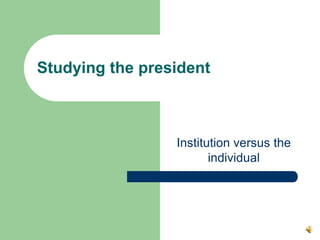
Presidency ii
- 1. Institution versus the individual Studying the president
- 2. BarberThe Presidential Character, 1972 A psychological approach that focuses on the ways that interpersonal experiences shape individual characteristics that then influence how the Presidents perform. Personality and President President’s personality is important for understanding Presidential behavior Best way to predict personality is to look at a President’s formative years
- 3. Dimensions Active- Passive -- how much energy does he invest in the Presidency Active Passive Positive Active-Positive: much activity and an enjoyment of it. High self-esteem and relative success in dealing with the environment. Wants to achieve results Passive-Positive: Very other-directed character, constantly searching for affection by trying to please everyone. Superficial optimism. Wants love Negative Active-Negative: intense effort with a low level of emotional reward for that effort. ambitious and aggressive with a vague, discontinuous self-image. Wants to get and keep power Passive-Negative: sees public service as a “duty” that he is called to fill, but is not happy about it. Stoic or martyr like. Emphasize their civic virtue Positive-Negative-- whether or not he seems to enjoy his political office/ life
- 4. Barber, Presidential Character "The danger is that Nixon will commit himself irrevocably to some disastrous course of action"
- 5. Presidential Power and the Modern Presidents: Neustadt All presidents are “clerks”: they accomplish a wide range of tasks, but clerkship is not leadership. The strength or weakness of a President is measured in his ability to influence or persuade the other individuals who are part of running the country Power=Influence
- 6. FDR as the ideal president Should we compare Obama?
- 7. Going Public Engaging in intensive public relations to promote their policies to the voters and thereby induce cooperation from other elected office holders. Example– Reagan and Iran-Contra Clinton and the government shut down tone of State of the Union
- 8. Past Press conferences Weekly radio addresses Present– the technology question Weekly web address The official White House MySpace page White House on Twitter
- 11. Thinking about institutional constraints
- 12. Institution versus person? Difference in method and variables Which better explains nuts and bolts of decision-making Two ways of assessing White House Organization.
- 13. Institutional pressures Expectations of president after FDR– president as the ultimate scape-goat Clinton and the economy Bush and the economy Expansion of the Executive Office of the President (EOP)
- 14. Congress Prefers decentralized, insulated bureaucracy Preference guided by INSTITUTIONAL constraint of re-election pressure Because social fear of state, Congress goes along with their preferenc. Presidency Prefers centralized, unified, coordinated bureaucracy that they control from the top. Preference guided by the blame they receive. “Presidents are held responsible by the public for virtually every aspect of national performance…”
- 15. Institutions also help… Constitutional and delegated powers allow for assertion of leadership through action. Action hard to reverse by Congress because of legislative difficulties.
- 16. Additional takes on constraints The Obama promise– to change politics in Washington as we know it Obama tries to follow through on promise. Partisanship raises its head.